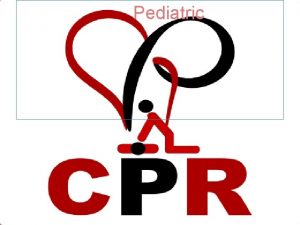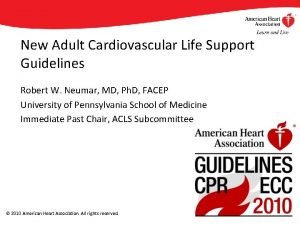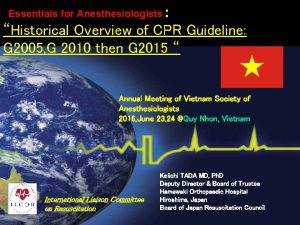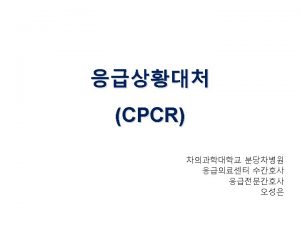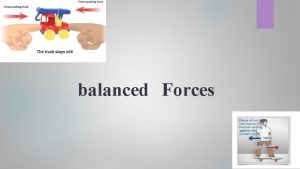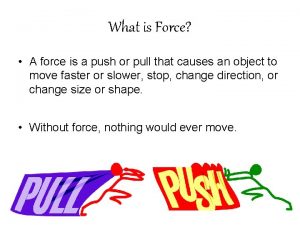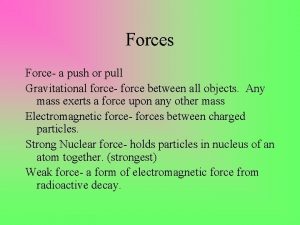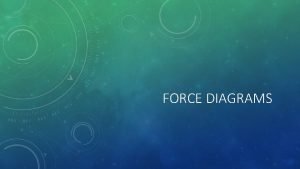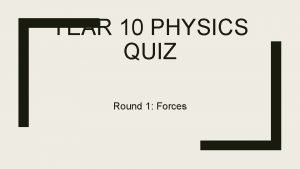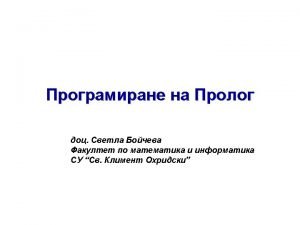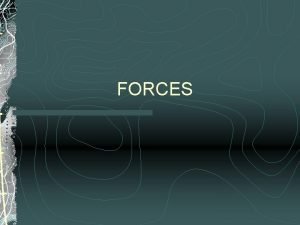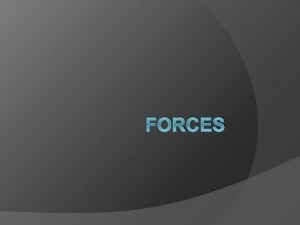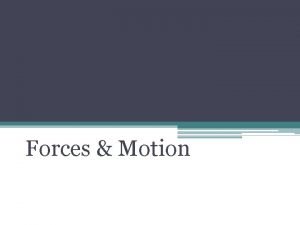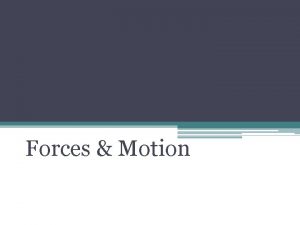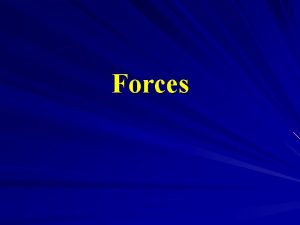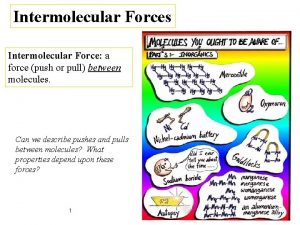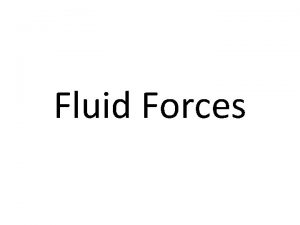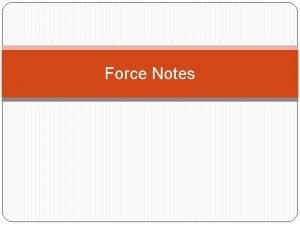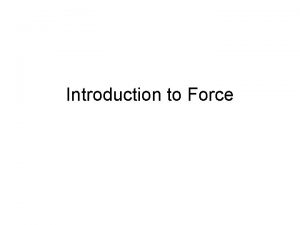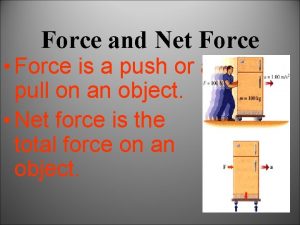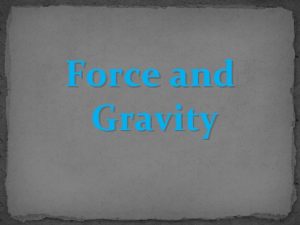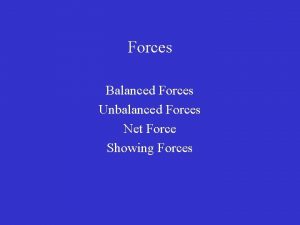Part 2 Forces A force is a push























- Slides: 23

Part 2 - Forces

• A force is a push or pull upon an object resulting from the object's interaction with another object. Whenever there is an interaction between two objects, there is a force upon each of the objects. When the interaction ceases, the two objects no longer experience the force. Forces only exist as a result of an interaction.

Contact Forces Action-at-a-Distance Forces Frictional Force Gravitational Force Tension Force Electrical Force Normal Force Magnetic Force Air Resistance Force Applied Force Spring Force

Newtons • Force is a quantity that is measured using the standard metric unit known as the Newton. • A Newton is abbreviated by an "N. “ • One Newton is the amount of force required to give a 1 -kg mass an acceleration of 1 m/s/s. Thus, the following unit equivalency can be stated: • 1 Newton = 1 kg • m/s 2

• A force is a vector quantity. Remember - a vector quantity is a quantity that has both magnitude and direction.

Balanced Forces

Unbalanced Forces

Types of Forces

An applied force is a force that is Applied applied to an object by a person or Force another object. If a person is pushing F a desk across the room, then there is an applied force acting upon the object. The applied force is the force exerted on the desk by the person. app

Gravity Force (also known as Weight) Fgrav The force of gravity is the force with which the earth, moon, or other massively large object attracts another object towards itself. By definition, this is the weight of the object. All objects upon earth experience a force of gravity that is directed "downward" towards the center of the earth. The force of gravity on earth is always equal to the weight of the object as found by the equation: Fgrav = m * g where g = 9. 8 N/kg (on Earth)and m = mass (in kg)

Normal The normal force is the support force Force exerted upon an object that is in contact Fnorm with another stable object. For example, if a book is resting upon a surface, then the surface is exerting an upward force upon the book in order to support the weight of the book. On occasions, a normal force is exerted horizontally between two objects that are in contact with each other. For instance, if a person leans against a wall, the wall pushes horizontally on the person.

Friction Force Ffrict The friction force is the force exerted by a surface as an object moves across it or makes an effort to move across it. There at least two types of friction force - sliding and static friction. Though it is not always the case, the friction force often opposes the motion of an object. For example, if a book slides across the surface of a desk, then the desk exerts a friction force in the opposite direction of its motion. Friction results from the two surfaces being pressed together closely, causing intermolecular attractive forces between molecules of different surfaces. As such, friction depends upon the nature of the two surfaces and upon the degree to which they are pressed together. The maximum amount of friction force that a surface can exert upon an object can be calculated using the formula below: Ffrict = µ • Fnorm

Air Resistance Force Fair The air resistance is a special type of frictional force that acts upon objects as they travel through the air. The force of air resistance is often observed to oppose the motion of an object. This force will frequently be neglected due to its negligible magnitude (and due to the fact that it is mathematically difficult to predict its value). It is most noticeable for objects that travel at high speeds (e. g. , a skydiver or a downhill skier) or for objects with large surface areas.

Tension Force Ftens The tension force is the force that is transmitted through a string, rope, cable or wire when it is pulled tight by forces acting from opposite ends. The tension force is directed along the length of the wire and pulls equally on the objects on the opposite ends of the wire.

Spring Force Fspring The spring force is the force exerted by a compressed or stretched spring upon any object that is attached to it. An object that compresses or stretches a spring is always acted upon by a force that restores the object to its rest or equilibrium position. For most springs (specifically, for those that are said to obey "Hooke's Law"), the magnitude of the force is directly proportional to the amount of stretch or compression of the spring.

1. Complete the following table showing the relationship between mass and weight. Object Mass (kg) Melon 1 kg Apple Pat Eatladee Fred Weight (N) 0. 98 N 25 kg 980 N

• 2. Different masses are hung on a spring scale calibrated in Newtons. • The force exerted by gravity on 1 kg = 9. 8 N. • The force exerted by gravity on 5 kg = ______ N. • The force exerted by gravity on _______ kg = 98 N. • The force exerted by gravity on 70 kg = ____ N.

• 3. When a person diets, is their goal to lose mass or to lose weight? Explain.

Free Body Diagrams

• Free-body diagrams are diagrams used to show the relative magnitude and direction of all forces acting upon an object in a given situation. A free-body diagram is a special example of the vector diagrams.

• Objects do not necessarily always have four forces acting upon them. There will be cases in which the number of forces depicted by a free -body diagram will be one, two, or three. There is no hard and fast rule about the number of forces that must be drawn in a free -body diagram. The only rulefor drawing freebody diagrams is to depict all the forces that exist for that object in the given situation.

A book is at rest on a tabletop. Diagram the forces acting on the book.

A girl is suspended motionless from the ceiling by two ropes. Diagram the forces acting on the combination of girl and bar
 Push hard push fast fully recoil
Push hard push fast fully recoil Push hard push fast fully recoil
Push hard push fast fully recoil Push hard push fast fully recoil
Push hard push fast fully recoil Pea rhythm
Pea rhythm Push hard push fast fully recoil
Push hard push fast fully recoil Mild foreign-body airway obstruction
Mild foreign-body airway obstruction Push and pull forces definition
Push and pull forces definition Type of force applied
Type of force applied Gravitational force push or pull
Gravitational force push or pull Market pull definition
Market pull definition Radial engine valve operating mechanism
Radial engine valve operating mechanism Amy uses 20 n of force to push a lawn mower 10 meters
Amy uses 20 n of force to push a lawn mower 10 meters Market pull technology push
Market pull technology push Define like parallel forces
Define like parallel forces The forces shown above are
The forces shown above are Intra vs intermolecular forces
Intra vs intermolecular forces Similarities of intermolecular and intramolecular forces
Similarities of intermolecular and intramolecular forces Intramolecular forces vs intermolecular forces
Intramolecular forces vs intermolecular forces What are some contact forces and some noncontact forces?
What are some contact forces and some noncontact forces? Net force
Net force What is constructive force
What is constructive force Physics free body diagram
Physics free body diagram Which of the following forces is a contact force? *
Which of the following forces is a contact force? * Non contact forces portfolio
Non contact forces portfolio
